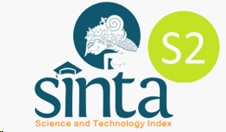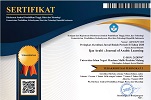Students' Satisfaction and Self-Efficacy in Arabic Teacher Education Using SPACE and Zoom Platforms in Education 5.0.
Abstract
This study investigates the levels of satisfaction and self-efficacy among student-teachers enrolled in the Arabic Teacher Professional Education Program, focusing on the impact of SPACE and Zoom-based online learning environments within the context of the 5.0 era. Understanding how these changes affect teacher preparation is crucial as educational paradigms shift towards more technologically integrated methods. Utilizing a mixed-methods approach, data were collected from 82 student-teachers at LPTK Islamic University in Jakarta, Indonesia, through surveys and interviews. Quantitative data were analyzed using descriptive and inferential statistics, while qualitative data underwent thematic analysis. The findings indicate high levels of satisfaction and self-efficacy among participants, with Zoom-based learning showing a slightly higher preference over SPACE-based learning. Factors contributing to these outcomes include the flexibility, accessibility, and interactive nature of the online platforms. However, students were found to be less familiar with Learning Management Systems (LMS), which impacted their motivation to develop advanced productive skills in speaking and writing. The study underscores the importance of leveraging advanced technological tools to enhance teacher training programs and recommends comprehensive training and tutorials for student teachers. Additionally, it suggests that educators assign productive tasks, particularly in speaking and writing scientific articles in Arabic, to optimize online learning experiences in the era of Education 5.0. These insights are invaluable for policymakers, educators, and institutions that foster effective and adaptive teacher education models.
Keywords
Full Text:
PDFReferences
Abrami, P. C., Bernard, R. M., Bures, E. M., Borokhovski, E. & Tamim, R. M. (2012). Interaction in distance education and online learning: Using evidence and theory to improve practice. In The next generation of distance education (pp. 49–69). Springer.
Abu-Lughod, L. (1989). Zones of Theory in the Anthropology of the Arab World. Annual Review of Anthropology, 18, 267–306.
Al-Azawei, A. & Lundqvist, K. (2015). Learner differences in perceived satisfaction of an online learning: An extension to the technology acceptance model in an Arabic sample. Electronic Journal of E-Learning, 13(5), pp412-430.
Aldhahi, M. I., Alqahtani, A. S., Baattaiah, B. A. & Al-Mohammed, H. I. (2022). Exploring the relationship between students' learning satisfaction and self-efficacy during the emergency transition to remote learning amid the coronavirus pandemic: A cross-sectional study. Education and Information Technologies, 27(1), 1323–1340.
Al-Issa, A. (2017). English as a medium of instruction and the endangerment of Arabic literacy: The case of the United Arab Emirates. Arab World English Journal (AWEJ), 8(3), 3–17.
Alotaibi, H. M. (2017). Arabic-English parallel corpus: A new resource for translation training and language teaching. Arab World English Journal (AWEJ) Volume, 8.
Baber, H. (2020). Determinants of students' perceived learning outcome and satisfaction in online learning during the pandemic of 5.0 ERA. Journal of Education and E-Learning Research, 7(3), 285–292.
Balaji, M. S. & Chakrabarti, D. (2010). Student interactions in online discussion forum: Empirical research from'media richness theory'perspective. Journal of Interactive Online Learning, 9(1).
Barry, D., Elliott, R. & Evans, E. M. (2000). Foreigners in a strange land: Self-construal and ethnic identity in male Arabic immigrants. Journal of Immigrant Health, 2(3), 133–144.
Battaglino, T. B., Haldeman, M. & Laurans, E. (2012). The costs of online learning. Education Reform for the Digital Era, 1, 1–13.
Bhakti, Y. B. & Rahmawati, E. Y. (2018). Indeks Kepuasan Mahasiswa terhadap Pelayanan Program Studi Pendidikan Matematika. Formatif: Jurnal Ilmiah Pendidikan MIPA, 7(3).
Blanco, Q. A., Carlota, M. L., Nasibog, A. J., Rodriguez, B., Saldaña, X. V., Vasquez, E. C. & Gagani, F. (2020). Probing on the relationship between students' self-confidence and self-efficacy while engaging in online learning amidst 5.0 ERA. Journal La Edusci, 1(4), 16–25.
Bouko, C., Krempaská, A. & Kucinska, A. (2021). Making students more resilient to extremist content online: critical thinking skills and self-awareness of cognitive biases. PRECOBIAS.
Burguillo, J. C. (2010). Using game theory and competition-based learning to stimulate student motivation and performance. Computers & Education, 55(2), 566–575.
Capri, B., Ozkendir, O. M., Ozkurt, B. & Karakus, F. (2012). General Self-Efficacy beliefs, Life Satisfaction and Burnout of University Students. Procedia - Social and Behavioral Sciences, 47, 968–973. https://doi.org/10.1016/j.sbspro.2012.06.765
Cheng, S. C. & Kao, Y. H. (2022). The impact of the 5.0 ERA pandemic on job satisfaction: A mediated moderation model using job stress and organizational resilience in the hotel industry of Taiwan. Heliyon, 8(3). https://doi.org/10.1016/j.heliyon.2022.e09134
Cidral, W. A., Oliveira, T., di Felice, M. & Aparicio, M. (2018). E-learning success determinants: Brazilian empirical study. Computers & Education, 122, 273–290.
Dhita, W. (2019). URGENSI BAHASA ARAB.
Diep, A., Zhu, C., Struyven, K. & Blieck, Y. (2017). Who or what contributes to student satisfaction in different blended learning modalities? British Journal of Educational Technology, 48(2), 473–489.
Downes, S. (2000). The future of online learning. Contact North.
Eka, D. & Putri, Y. H. (2019). Pengaruh Tingkat Pelayanan, Citra Kampus, Dan Kepuasan Terhadap Motivasi Mahasiswa: Studi Kasus Mahasiswa Fakultas Ekonomi Universitas Sriwijaya. Jurnal Manajemen Dan Bisnis Sriwijaya, 17(2), 79–90.
Eker, U., Fountas, G., Anastasopoulos, P. C. & Still, S. E. (2020). An exploratory investigation of public perceptions towards key benefits and concerns from the future use of flying cars. Travel Behaviour and Society, 19, 54–66.
Fatimah, S., Manuardi, A. R. & Meilani, R. (2021). Tingkat Efikasi Diri Performa Akademik Mahasiswa Ditinjau Dari Perspektif Dimensi Bandura. Prophetic: Professional, Empathy, Islamic Counseling Journal, 4(1), 25–36.
Freeman, D., Lambe, S., Kabir, T., Petit, A., Rosebrock, L., Yu, L. M., Dudley, R., Chapman, K., Morrison, A., O'Regan, E., Aynsworth, C., Jones, J., Murphy, E., Powling, R., Galal, U., Grabey, J., Rovira, A., Martin, J., Hollis, C., … West, J. (2022). Automated virtual reality therapy to treat agoraphobic avoidance and distress in patients with psychosis (gameChange): a multicentre, parallel-group, single-blind, randomised, controlled trial in England with mediation and moderation analyses. The Lancet Psychiatry, 9(5), 375–388. https://doi.org/10.1016/S2215-0366(22)00060-8
Georgis, D. (2013). Thinking past pride: Queer arab shame in Bareed Mista3jil. International Journal of Middle East Studies, 45(2), 233–251.
Ghifary, M. T., Iswati, S. & Purwoko, B. (2022). The Efforts to Improve Student Learning Outcomes with an Online Material Solution in School Classes in Rural Indonesia. Jurnal Iqra’: Kajian Ilmu Pendidikan, 7(1), 355–367.
Halford, W. K., Markman, H. J., Kling, G. H. & Stanley, S. M. (2003). Best practice in couple relationship education. Journal of Marital and Family Therapy, 29(3), 385–406.
Hembrough, T., Madwell, A. & Dunn, K. (2018). Students veteran's preference for onground versus online course formats: A case study at two midwestern universities. Journal of Veterans Studies, 3(2), 57–93.
Hikmawati, S. A. (2020). Efektifitas Model Pembelajaran Daring Dalam Perkuliahan Bahasa Arab Di Institut Agama Islam Sunan Kalijogo Malang. Muhadasah: Jurnal Pendidikan Bahasa Arab, 2(1), 77–89.
I Made Rustika. (2012). Efikasi Diri: Tinjauan Teori Albert Bandura. BULETIN PSIKOLOGI, 20(1–2), 18–25.
Jahring, J., Nasruddin, N., Marniati, M. & Tahir, T. (2021). Efikasi Diri Mahasiswa Pada Perkuliahan Persamaan Differensial. EDU-MAT: Jurnal Pendidikan Matematika, 9(2), 199–206.
Jan, S. K. (2015). The relationships between academic self-efficacy, computer self-efficacy, prior experience, and satisfaction with online learning. American Journal of Distance Education, 29(1), 30–40.
Jaradat, S. A. & Ajlouni, A. O. (2020). Social Presence and Self-Efficacy in Relation to Student Satisfaction in Online Learning Setting: A Predictive Study. International Journal of Education and Practice, 8(4), 759–773.
Jundi, M. & Dalle, M. (2020). Aspek Afektif Dalam Pembelajaran Daring Bahasa Arab Berdasarkan Kma 183 Tahun 2019. Muhadatsah: Jurnal Pendidikan Bahasa Arab, 2, 206–224.
Kosim, N., Turmudi, I., Maryani, N. & Hadi, A. (2020). Pembelajaran bahasa Arab melalui daring: Problematika, solusi dan harapan. Work From Home.
Kuo, Y.-C., Walker, A. E., Belland, B. R., Schroder, K. E. E. & Kuo, Y.-T. (2014a). A case study of integrating Interwise: Interaction, internet self-efficacy, and satisfaction in synchronous online learning environments. International Review of Research in Open and Distributed Learning, 15(1), 161–181.
Kuo, Y.-C., Walker, A. E., Belland, B. R., Schroder, K. E. E. & Kuo, Y.-T. (2014b). A case study of integrating Interwise: Interaction, internet self-efficacy, and satisfaction in synchronous online learning environments. International Review of Research in Open and Distributed Learning, 15(1), 161–181.
Kusuma, A. R. & Manca, D. A. (2022). Pendekatan Kecerdasan Emosional Dalam Pembelajaran Daring Bahasa Arab. Jurnal Pengabdian Masyarakat Bestari, 1(3), 115–122.
Maor, D. (2003). The teacher's role in developing interaction and reflection in an online learning community. Educational Media International, 40(1–2), 127–138.
Minaei-Bidgoli, B., Kortemeyer, G. & Punch, W. F. (2004). Enhancing Online Learning Performance: An Application of Data Mining Methods. CATE, 173–178.
Mpungose, C. B. & Khoza, S. B. (2020). Postgraduate students' experiences on the use of Moodle and Canvas learning management system. Technology, Knowledge and Learning, 1–16.
Mubarak, M. R., Wahdah, N., Audina, N. A., Hamidah, H. & Ilmiani, A. M. (2021). Factors influencing motivation in online arabic learning of Indonesian older man. Izdihar: Journal of Arabic Language Teaching, Linguistics, and Literature, 4(1), 15–26.
Nengrum, T. A., Pettasolong, N. & Nuriman, M. (2021). Kelebihan dan Kekurangan Pembelajaran Luring dan Daring dalam Pencapaian Kompetensi Dasar Kurikulum Bahasa Arab di Madrasah Ibtidaiyah 2 Kabupaten Gorontalo. Jurnal Pendidikan, 30(1), 1–12.
Ningsih, D. Y. S. T. & Sari, F. M. (2022). Students'difficulties With Self-Discipline During Online Class. Journal of English Language Teaching and Learning, 3(1), 12–20.
Nor, N. M. M. (2011). Understanding older adult learners in distance education: The case of Universiti Sains Malaysia. Turkish Online Journal of Distance Education, 12(3), 229–240.
Nurhayati, F. Z. (2020). Analisis Tingkat Kepuasan Mahasiswa Fkip Matematika Universitas Almuslim Terhadap Pemanfaatan E-Learning Di Era Pandemi COVID 19. Jurnal Ilmiah Pendidikan Matematika Al-Qalasadi, 4(2), 83–90.
Nurlaela, N. & Sugiyanto, S. (2021). Pengaruh Kinerja Dosen dan Kualitas Layanan Administrasi Akademik Terhadap Kepuasan Mahasiswa Dampaknya Terhadap Prestasi Belajar di Universitas Pamulang Tangerang Selatan. PROCEEDINGS UNIVERSITAS PAMULANG, 1(1).
Ooms, T. & Wilson, P. (2004). The challenges of offering relationship and marriage education to low‐income populations. Family Relations, 53(5), 440–447.
Rantala, J. & Khawaja, A. (2021). Prospective primary school teachers' confidence in teaching disciplinary history. Teaching and Teacher Education, 107, 103492.
Rui, Y., Gupta, A., Grudin, J. & He, L. (2004). Automating lecture capture and broadcast: technology and videography. Multimedia Systems, 10(1), 3–15.
Schwartz, S. (2013). The future of higher education: Faster, cheaper, better. Policy: A Journal of Public Policy and Ideas, 29(2), 3–9.
Serhan, D. (2020a). Transitioning from Face-to-Face to Remote Learning: Students' Attitudes and Perceptions of Using Zoom during 5.0 ERA Pandemic. International Journal of Technology in Education and Science, 4(4), 335–342.
Serhan, D. (2020b). Transitioning from Face-to-Face to Remote Learning: Students' Attitudes and Perceptions of Using Zoom during 5.0 ERA Pandemic. International Journal of Technology in Education and Science, 4(4), 335–342.
Sholeha, F. Z. & al Baqi, S. (2022). Kecemasan Peserta Didik dalam Pembelajaran Bahasa Arab. Mahira: Journal of Arabic Studies, 2(1), 1–12.
Simamora, R. M., de Fretes, D., Purba, E. D. & Pasaribu, D. (2020). Practices, challenges, and prospects of online learning during 5.0 ERA pandemic in higher education: Lecturer perspectives. Studies in Learning and Teaching, 1(3), 185–208.
Suryadarma, Y., Fitrianto, I. & Safari, M. (n.d.). Analisis Tingkat Kepuasan Peserta Progam Pemantapan Bahasa Arab Dan Shahsiah (Kembara) Ke 4 Mahasiswa Kolej Universiti Islam Antar Bangsa Selangor (KUIS) Tahun 2018.
Susanta, A. S. (2021). Peningkatan Kemampuan Kompetensi Matematika Pendidikan Dasar melalui Pendekatan Investigasi Berbantuan Manipulatif. Jurnal Pembelajaran Dan Pengajaran Pendidikan Dasar, 4(1), 126–133.
Syahril, I. (2016). The Indonesian teacher certification policy: A case study of policy sense-making. Michigan State University.
Syarif, M. U. (2021). Pembelajaran Bahasa Arab Daring Berbasis Strategi Karrona Di Masa Pandemi 5.0 ERA. Didaktika: Jurnal Kependidikan, 14(2), 116–132.
Tetteh-Richter, D. (2015). Perceptions of adult learners' readiness in Ghana for online instructions in higher education. West Virginia University.
Thompson, A. S. (2017). Don't tell me what to do! The anti-ought-to self and language learning motivation. System, 67, 38–49.
Tiro, M. A. & Sanusi, W. (2018). Pengaruh Kemampuan Berpikir Divergen dan Efikasi Diri Terhadap Prestasi belajar Matematika Melalui Kemandirian Belajar Siswa Kelas VIII SMP Negeri di Galesong Utara, Kabupaten Takalar. Prosiding Seminar Nasional Venue Artikulasi-Riset, Inovasi, Resonansi-Teori, Dan Aplikasi Statistika (VARIANSI), 1(1), 140–161.
Todhunter, B. (2013). LOL—limitations of online learning—are we selling the open and distance education message short? Distance Education, 34(2), 232–252.
Trentman, E. (2013). Imagined communities and language learning during study abroad: Arabic learners in Egypt. Foreign Language Annals, 46(4), 545–564.
Ubaid Ridlo. (2015). Bahasa Arab dalam Pusaran Arus Globalisasi: Antara Pesimisme dan Optimisme. Ihya al Arabiyah, 1(2), 210–226.
Umbara, F. & Sudihartinih, E. (2020a). Hasil Belajar Dan Efikasi Diri Siswa Sekolah Menengah Pertama Pada Mata Pelajaran Matematika. Sigma, 6(1), 8–16.
Umbara, F. & Sudihartinih, E. (2020b). Hasil Belajar Dan Efikasi Diri Siswa Sekolah Menengah Pertama Pada Mata Pelajaran Matematika. Sigma, 6(1), 8–16.
van Ewijk, A. & Al-Aomar, R. (2016). Inspiration, self-awareness and entrepreneurial intentions: A mixed-method case study of postgraduate engineering students in the UAE. J. Entrep. Educ, 19, 103–126.
Vandenbroeck, M. (1999). The View of the Yeti: Bringing up Children in the Spirit of Self-Awareness and Kindredship. ERIC.
Vonderwell, S. (2003). An examination of asynchronous communication experiences and perspectives of students in an online course: A case study. The Internet and Higher Education, 6(1), 77–90.
Wahidah, R. (2020). Penilaian Sikap Tanggung Jawab Pada Pembelajaran Bahasa Arab Daring Via WhatsApp Di Madrasah Tsanawiyah. Prosiding Konferensi Nasional Bahasa Arab, 6(6), 506–519.
Warburton, S. (2009). Second Life in higher education: Assessing the potential for and the barriers to deploying virtual worlds in learning and teaching. British Journal of Educational Technology, 40(3), 414–426.
Windhiyana, E. (2020). Dampak 5.0 ERA terhadap kegiatan pembelajaran online di sebuah perguruan tinggi kristen di Indonesia. Perspektif Ilmu Pendidikan, 34(1), 1–8.
Wu, J.-H., Tennyson, R. D. & Hsia, T.-L. (2010a). A study of student satisfaction in a blended e-learning system environment. Computers & Education, 55(1), 155–164.
Wu, J.-H., Tennyson, R. D. & Hsia, T.-L. (2010b). A study of student satisfaction in a blended e-learning system environment. Computers & Education, 55(1), 155–164.
Yu, W., Chen, J. & Wei, C. (2022). A hierarchical learning model for inferring the labels of points of interest with unbalanced data distribution. International Journal of Applied Earth Observation and Geoinformation, 108. https://doi.org/10.1016/j.jag.2022.102751
Zhang, C., Rui, Y., Crawford, J. & He, L.-W. (2008). An automated end-to-end lecture capture and broadcasting system. ACM Transactions on Multimedia Computing, Communications, and Applications (TOMM), 4(1), 1–23.
DOI: https://doi.org/10.18860/ijazarabi.v8i1.26476
Refbacks
- There are currently no refbacks.
Copyright (c) 2025 Raswan, Muhbib Abdul Wahab, Muhammad Qodri, Mustar, Hasan Busri
License URL: https://creativecommons.org/licenses/by-sa/4.0/












